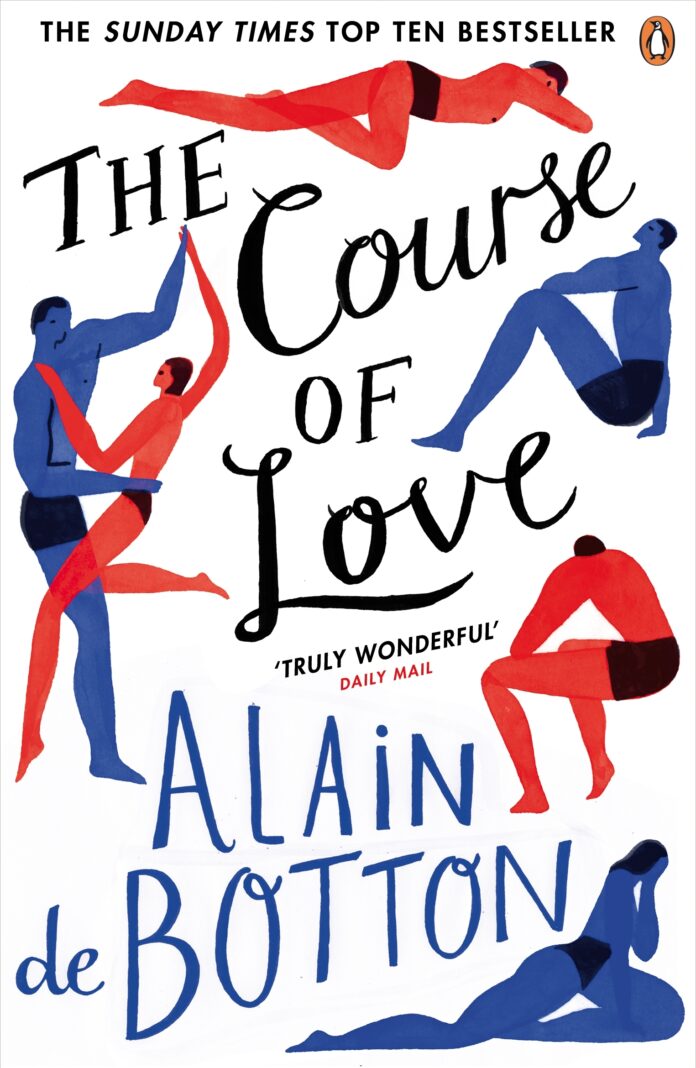In a literary landscape often enamored with fairy-tale romance and idealized courtships, Alain de Botton’s The Course of Love offers a refreshingly honest exploration of the complexities that underpin long-term relationships. delves into the nuanced emotional terrain that de botton navigates, inviting readers to reconsider the nature of love beyond its initial spark. this review aims to unpack the philosophical insights and narrative choices that render the novel both a thoughtful meditation and a candid portrayal of partnership’s evolving journey.
The intricate Portrayal of Modern Relationships and Emotional Complexity in The Course of Love Explored

The novel’s structure mirrors the unpredictability and complexity of real-life connections, employing moments of introspection and candid conversations that underscore the importance of emotional honesty. Key themes explored include:
- Communication breakdowns and their gradual repair
- The impact of personal histories on shared experiences
- The tension between individual growth and joint commitment
- Emotional labor as an often invisible force within relationships
These elements combine to create a rich tapestry illustrating that love is less about fleeting sparks and more about continuous effort and empathy. To better understand this balance,consider the table below:
| Aspect | Idealized View | De Botton’s Outlook |
|---|---|---|
| Passion | Constant and intense | Fluctuates and requires nurturing |
| Communication | Effortless understanding | Requires patience and openness |
| Conflict | Sign of failure | Natural part of growth |
This thorough examination reveals that emotional complexity is not a hurdle but the very foundation upon which lasting love is built.
how Alain de Botton’s Narrative style Enhances the Reader’s Connection with Love’s Realities and Challenges

Alain de botton’s narrative technique is a subtle blend of intimacy and intellectual clarity that deeply resonates with readers navigating the intricate terrain of love. By weaving a story that equally honors the poetic highs and the mundane struggles of relationships, he invites readers to see themselves reflected in every joy and tension. His prose often pauses to dissect emotions with philosophical insights,turning what might be dismissed as mere anecdotal experience into global truths. This dual lens creates a rich tapestry where the emotional complexities of love become approachable rather than overwhelming, fostering a sense of understanding and empathy.
Moreover, de Botton’s style emphasizes the *imperfections* and *contradictions* inherent in any partnership, stripping away the idealized veneer common in romantic fiction. The reader is drawn into a world where:
- Love is not always effortless, but requires constant work and vulnerability.
- Conflict is a catalyst for growth,not a sign of failure.
- Every individual brings their own baggage and beauty, shaping the evolving dynamic.
This candid approach helps dismantle unrealistic expectations and encourages a more grounded gratitude of love’s realities, enabling a connection that feels truthful, enduring, and nourishing.
Examining the Psychological Depth and Philosophical Reflections Embedded in the Storytelling
Alain de Botton’s narrative doesn’t simply chronicle the events of love; it plunges into the intricate web of human psychology that underpins romantic entanglements. By dissecting the insecurities, fears, and subconscious desires of his characters, the storytelling offers a profound exploration of emotional vulnerability. The tale reveals how *our inner dialogues* shape the trajectory of relationships, inviting readers to reflect on their own psychological patterns. This approach transcends conventional romance, transforming love into a multidimensional experience where the mind’s fragility is as prominent as passion itself.
Philosophically, the story serves as a meditation on the nature of happiness, expectation, and endurance within a partnership. De Botton weaves key contemplations on existential themes through poetic reflections and dialogue, encouraging a reevaluation of societal myths about love’s permanence and perfection. The narrative subtly challenges the belief in love as a static ideal, instead portraying it as a dynamic, evolving process:
- Love as continual negotiation rather than instantaneous bliss
- acceptance of imperfection as foundational to lasting bonds
- Embracing change as essential for growth within togetherness
| Psychological Insight | Philosophical Reflection |
|---|---|
| Fear of abandonment shaping behaviors | Reconceiving love beyond idealization |
| Unconscious needs influencing conflicts | Embracing vulnerability as strength |
| Emotional resilience through understanding | Love as an ongoing commitment, not a destination |
the Role of Everyday Life Moments and Mundane Experiences in Shaping the Portrait of Lasting Love

In de Botton’s narrative, love is not simply the fiery passion of cinematic moments but an intricate mosaic assembled from the fabric of daily existence. The subtle acts-making coffee, shared silences, the gentle friction of differing opinions-carry profound weight in the architecture of enduring relationships. These seemingly insignificant fragments are the ground upon which trust and understanding take root, demonstrating that lasting love thrives not in grand gestures but in the patient cultivation of familiarity. It is indeed within the mundane that the remarkable quietly unfolds, revealing how routine moments are the silent poets of romance.
Key elements illustrating this idea include:
- Small acts of care: Remembering preferences, preparing a favorite meal without prompting.
- Emotional transparency: Navigating imperfections with honesty and humor.
- Shared history: Building a private language from inside jokes and daily rhythms.
| Moment | Impact on Relationship |
|---|---|
| Morning routines | Sets a tone of companionship |
| Everyday disagreements | Fosters communication and growth |
| Shared chores | Reinforces teamwork and mutual respect |
By elevating the quotidian,de Botton challenges customary romantic ideals,suggesting that the true portrait of lasting love is painted through consistent,imperfect interactions. These slices of ordinary life are not obstacles but essential threads weaving a resilient tapestry of connection. Love’s endurance, then, is less a dramatic crescendo and more an ongoing dialogue-a continuous dance where the mundane becomes the foundation of the profound.
Insights into the Balance Between Romanticism and Realism as Depicted in the Book’s Characters
in Alain de Botton’s narrative, the characters embody a delicate dance between the idealized visions of love and the grounded, sometimes harsh, reality of relationships. Through their evolving journeys, we witness how romanticism breathes life into moments of passion and hope, painting love with vibrant hues of possibility.Yet, realism steadily tempers this exuberance, revealing the nuances of imperfections, everyday struggles, and emotional endurance that define lasting partnerships. This interplay is carefully woven into their personalities, allowing readers to resonate with the sweet allure and sobering truths of intimacy simultaneously.
- Romanticism: Dreams, idealism, and emotional intensity.
- Realism: Flaws,compromises,and the mundane routines that test love’s resilience.
The characters’ evolving perspectives serve as a mirror reflecting the reader’s own oscillation between hope and pragmatism in love. This balance is succinctly captured in the following table, illustrating key moments where romantic optimism clashes or melds with grounded understanding:
| Character Moment | Romantic Impulse | Realist Response |
|---|---|---|
| First Meeting | Idealized perception | Subtle doubts and reservations |
| Marriage | Fairytale expectations | Confrontation with routine struggles |
| conflict | Emotional intensity and blame | Need for communication and patience |
| Renewal | Hope for change | Acceptance of imperfection |
This dynamic tension steers the narrative beyond clichés, inviting a deeper reflection on how love is not a static ideal but an evolving blend of passion and practicality. Alain de Botton’s portrayal offers a nuanced map for readers navigating their own complex emotional landscapes.
A Close Look at the Evolution of Love Through Conflict, growth, and Intimacy Depicted in the Narrative
Alain de Botton’s narrative masterfully dissects the intricate dance between love and conflict, revealing how tension is not a sign of failure but a cornerstone of authenticity. Through the protagonists’ journey, we witness love’s capacity to withstand misunderstandings, harsh words, and moments of doubt. Instead of offering idealized romance, the story embraces emotional turbulence as a catalyst for deeper understanding and connection. The characters grow not by avoiding disagreements but by confronting them head-on, learning to negotiate vulnerability and boundaries with grace. This approach redefines conflict as an essential ingredient, enriching the texture of love rather than eroding it.
Integral to this evolution is the delicate weaving of growth and intimacy-a process that unfolds slowly, layer by layer. Love is depicted as a dynamic interplay where personal development and shared experience feed into one another. The narrative highlights key components driving this transformation:
- Empathy: Understanding one’s partner beyond surface behaviors.
- Patience: Allowing time for wounds to heal and trust to build.
- Honesty: Sharing fears and hopes without masks.
- Acceptance: Embracing imperfections as part of the shared journey.
| Stage of love | Key Emotion | Relationship Outcome |
|---|---|---|
| Early Infatuation | Excitement | Surface Connection |
| Conflict Engagement | Frustration | Authentic Understanding |
| Growth & Reflection | Patience | Renewed Trust |
| Deep Intimacy | Vulnerability | Enduring Bond |
How the Course of Love Challenges Conventional Ideas About Happiness and Partnership
The narrative boldly dismantles the fairy-tale notion that love is an unending cascade of blissful moments. Rather, it presents an honest portrayal of love as a continuous negotiation between two imperfect beings. By peeling back the layers of romance, the book reveals how happiness in partnership is less about perfect synchronicity and more about embracing vulnerability, patience, and growth together. This challenges the pervasive societal expectation that true love is effortless, suggesting instead that it requires resilience and a deep willingness to understand the complex emotional landscapes of both partners.
Key elements that redefine traditional views include:
- Acceptance of imperfection: Love is less about finding ‘the one’ and more about building a shared life amidst flaws.
- The role of conflict: Disagreements aren’t signs of love’s failure but opportunities for deeper connection.
- Emotional labor: Recognizing the frequently enough unseen efforts in maintaining intimacy and mutual support.
- The temporal nature of passion: Acknowledging that passion evolves and transforms rather than disappears.
| Conventional Idea | Course of Love’s Perspective |
|---|---|
| Love is effortless | Love requires continuous work |
| happiness means constant joy | Happiness includes navigating struggles |
| compatibility is static | Compatibility evolves over time |
The Relevance of de Botton’s Work in Contemporary Discussions on Emotional Intelligence and Relationships
Alain de Botton’s exploration of love transcends mere romantic idealism, offering a nuanced lens through which modern emotional intelligence can be understood and applied. His emphasis on the realistic challenges couples face-such as misunderstandings, insecurity, and evolving desires-echoes contemporary psychological findings about emotional awareness and regulation. De Botton encourages readers to embrace vulnerability and patience, key components in nurturing emotional growth within relationships. This perspective aligns seamlessly with current dialogues that prioritize empathy, self-reflection, and communication as vital tools for sustaining deep connections beyond infatuation.
Moreover, the book’s portrayal of love as a continuous, dynamic journey rather than a fixed state provides valuable insights often overlooked in mainstream relationship advice. The following table outlines some key emotional competencies highlighted by de botton alongside their contemporary equivalents in emotional intelligence frameworks:
| De Botton’s Concept | emotional Intelligence Component | Impact on Relationships |
|---|---|---|
| Acceptance of Imperfection | Self-Awareness | Fosters realistic expectations |
| Commitment through Challenges | Resilience | Strengthens long-term bonds |
| Embracing Vulnerability | Emotional Transparency | enhances trust and intimacy |
- Encourages introspection over superficial attraction
- Promotes emotional patience in moments of conflict
- Challenges cultural myths about instant romantic fulfillment
Practical Takeaways and Thought-Provoking Questions for Readers to Reflect on Their Own Love journeys
- Understanding love as an ongoing dialogue, not a static state
- Valuing emotional honesty over superficial harmony
- Recognizing growth through challenges as a gift, not a setback
- Cultivating empathy to bridge the inevitable disconnects
To deepen your reflection, ask yourself:
| Question | Why It matters |
|---|---|
| How do I respond when love feels challenging rather of seamless? | Understanding your responses illuminates how resilience and vulnerability play roles in your love journey. |
| What assumptions about perfect love have I held that might limit my connection? | Challenging idealized notions frees you to experience love more authentically. |
| In what ways can empathy shift my perspective during conflicts? | Cultivating empathy transforms conflict into an opportunity for deeper understanding. |
visual and Literary Elements That Support the Book’s Themes and Enhance the Reflective Experience
Alain de botton masterfully employs a blend of visual and literary techniques that deepen the reader’s immersion into the complex world of love. Through his use of vivid metaphors and insightful interjections, the narrative transcends a simple love story, becoming a mirror reflecting our own emotional landscapes. The sporadic inclusion of philosophical musings, paired with clinical observations of everyday relationship dynamics, invites readers to pause and consider the frequently enough unspoken undercurrents shaping affection and conflict alike. This interplay between storytelling and introspection enhances the reflective experience by framing personal growth as an essential, ongoing process within love’s journey.
Visually, the novel’s structure itself subtly reinforces its themes. The intermittent chapters punctuated by thematic essays act as lenses focusing on different facets of love’s many layers. Elements such as poetic line breaks, italicized reflections, and cleverly positioned diagrams and tables guide readers through a nuanced emotional map without overwhelming the narrative flow.
| Element | Function |
|---|---|
| Metaphors | Make abstract emotions tangible |
| Philosophical Essays | Encourage self-reflection |
| Italicized Passages | Highlight internal thoughts |
| Visual Tables | Organize complex ideas simply |
Collectively, these elements do more than embellish the text; thay serve as guideposts for readers navigating their own emotional terrain. By weaving form and content so seamlessly, de Botton transforms the act of reading into a participatory exploration, making the experience both intellectually stimulating and emotionally resonant.
recommendations for Readers Seeking a Thoughtful Exploration of Love Beyond Traditional Romance
To aid your journey,here are some thoughtful recommendations that will enhance your exploration of relational depth and self-awareness:
- Reflective journals: Keep a personal journal to track your thoughts and feelings as you read. This practice encourages active engagement and personal reflection, similar to the introspective nature of de Botton’s prose.
- Discussion groups or book clubs: Sharing insights with others can uncover new dimensions to love that solitary reading might not reveal.
- Complementary podcasts: Podcasts like “Where Should We Begin?” by Esther Perel offer real conversations that mirror the vulnerabilities and complexities explored in the book.
| Resource Type | example | Benefit |
|---|---|---|
| books | “The Art of Loving” | Explores love as an active skill rather than passive feeling |
| Podcasts | “Where Should we Begin?” | Offers real-life relationship therapy sessions |
| Journaling | Personal reflection | Deepens self-awareness and emotional processing |
The Course of Love’s Contribution to Alain de Botton’s Philosophical and Literary Legacy as a Writer
Alain de Botton’s The Course of Love intricately weaves philosophy and narrative to explore the mundane and profound aspects of romantic relationships. Unlike conventional love stories that often highlight passion and heartbreak, this work delves into the nuanced realities of sustaining love over time.De Botton challenges the cultural myth that love is solely a spontaneous burst of emotion, rather presenting it as an evolving practice requiring patience, understanding, and mutual growth. Through the journey of Rabih and kirsten, he illuminates the oft-overlooked moments where love’s true nature emerges-not in the highs, but in the quiet negotiations of life’s imperfections.
At the heart of the book lies a rich tapestry of insights that contribute significantly to de Botton’s overarching philosophical legacy.His approach can be summarized in the following key themes:
- Emotional Realism: A candid portrayal of love’s complexities beyond idealism.
- Philosophy Applied: Integrating existential and psychological reflections within everyday relationships.
- Educational Narrative: Offering readers tools to better understand and navigate love’s challenges.
| Aspect | Contribution |
|---|---|
| Literary Innovation | Blending novelistic storytelling with philosophical essays |
| Philosophical Depth | Demystifying love’s myths and presenting a grounded perspective |
| Practical Wisdom | Empowering readers with realistic expectations and emotional tools |
The Course of Love beckons readers not with grand romantic gestures, but with the quiet, intricate realities that underpin lasting relationships. Alain de Botton’s exploration invites us to peel back the layers of love-not to find a definitive answer, but to embrace its complexities with open eyes and thoughtful hearts. Whether you seek validation,challenge,or gentle reflection,this book offers a mirror to the tender,sometimes tangled journey we call love. As we close its pages,we are reminded that love is less a destination and more a continuous course-rich,unpredictable,and profoundly human.












